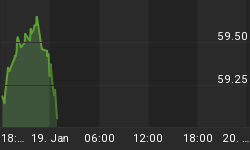Note: The following blog post originally appeared on April 4th, 2012 and is part of a continuing year-end 'best of' series, calling up old posts that some readers may have not seen before. I have removed some of the references to then-current market movements and otherwise cut the article down to the interesting bits. You can read the original post here.
...
I routinely deride economists who rely on the discredited notion that growth in excess of a nation's productive capacity is what causes inflation - and, conversely, a surplus of productive capacity is what causes deflation. See, for example, here, here, and here. And that is just in the last month!
I want to point out that it isn't that I don't believe in microeconomics (where an increase in supply causes prices to fall and a decrease in supply causes prices to rise). I believe deeply in the supply-demand construct.
But the problem with applying these ideas to the macroeconomy is that people get confused with real and nominal quantities, and they think of the "productive frontier" of an economy as being one thing rather than a multi-dimensional construct.
When an economy reaches "productive capacity," it isn't because it has used up all of its resources. It is because it has used up the scarcest resource. Theory says that what should happen isn't that all prices should rise, but that the price of the scarce resource should rise relative to the prices of other resources. For example, when labor is plentiful relative to capital, then what should happen is that real wages should stagnate while real margins increase - that is, because productivity is constrained by the scarce resource of capital, more of the economy's gains should accrue to capital. And so Marx was right, in this sort of circumstance: the "industrial reserve army of the unemployed" should indeed increase the share of the economic spoils that go to the kapitalists.
And that is exactly what is happening now. In the banking crisis, the nation's productive capacity declined because of a paucity of available capital, in particular because banks were forced to de-lever. Output declined, and after the shock adjustments the margins of corporate America rose sharply (which I recently illustrated here), near record levels from earlier in the decade of the 00s. And real wages stagnated. Be very clear on this point: it is real wages which are supposed to stagnate when labor is plentiful, not nominal wages.
Now, what should happen next in a free market system is that the real cost of capital should decline, or real wages should increase, or both, as labor is substituted for capital because of the shortage of capital. We indeed see that the real cost of capital is declining, because real rates are sharply negative out to 10 years and equities are trading at lusty multiples. But real wages are stagnating, going exactly nowhere over the last 36 months. Why is the adjustment only occurring on the capital side, with bull markets in bonds and stocks?
We can thank central bankers, and especially Dr. Bernanke and the Federal Reserve, for working assiduously to lower the cost of capital - also known as supporting the markets for capital. This has the effect, hopefully unintended, of lowering the level at which the convergence between real wages and the real cost of capital happens; and of course, it obviously also favors the existing owners of capital. By defending the owners of capital (and, among other things, refusing to let any of them go out of business), the Fed is actually helping to hold down real wages since there is no reason to substitute away from capital to labor!
But all of this happens in real space. One way that the real cost of capital and the real wage can stay low is to increase the price level, which is exactly what is happening. We call this inflation.
You can follow me @inflation_guy!
Enduring Investments is a registered investment adviser that specializes in solving inflation-related problems. Fill out the contact form at http://www.EnduringInvestments.com/contact and we will send you our latest Quarterly Inflation Outlook. And if you make sure to put your physical mailing address in the "comment" section of the contact form, we will also send you a copy of Michael Ashton's book "Maestro, My Ass!"















